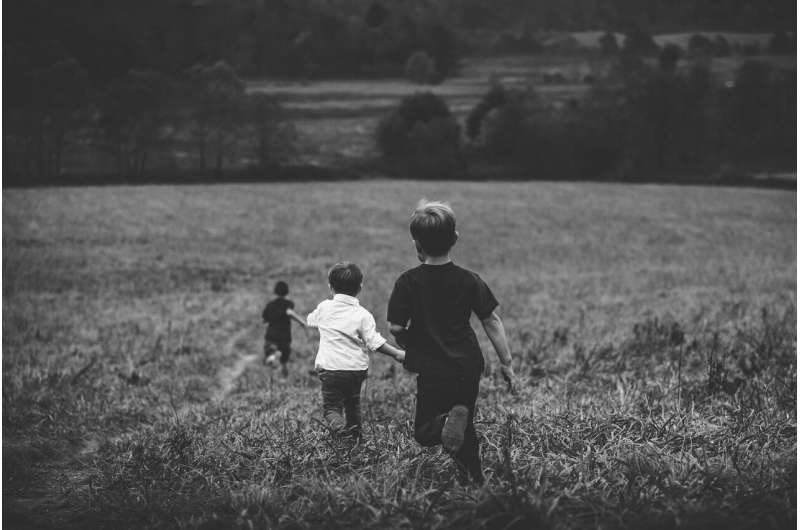Children who spend time in daylight are calmer

Children who spend a lot of time outdoors during the day display fewer symptoms of hyperactivity. A new study of kindergarten children show this to be a strong link.
"The difference between the brightness of indoor and outdoor light is considerable," says Vidar Sandsaunet Ulset, who is a psychologist and postdoctoral fellow at Promenta Research Centre at the University of Oslo. He is one of the researchers behind the study.
The study is a small part of a larger research study of 2000 children.
Previously, researchers have found a connection between the amount of time that children in kindergarten spend outdoors and higher levels of concentration and less hyperactivity in school.
Advanced bracelets
The new study included 48 kindergarten children at five kindergartens in Australia.
"We equipped the children with advanced bracelets that they wore around the clock for 14 days," Ulset says.
The bracelet had two sensors, one that measured the children's activity and the other how much light the child was exposed to.
In addition, the researchers asked the parents a number of questions about their child's behavior on the different days, such as whether they were restless, inattentive or were able to engage in an activity over time.
"This is an approved form used to detect symptoms of ADHD," says Ulset, but he emphasizes that the study participants were healthy children without ADHD.
Active for six and a half hours
According to the bracelets, the children were active for an average of six and a half hours a day. The calmest children were active for four and a half hours. The most active ones were in activity for nine and a half hours.
Ulset stresses that these activity levels aren't necessarily a sign of hyperactivity. It could be that the most active children are engaged in targeted play, like building a tree house.
The researchers found no association between how active the children were and the parents' reporting of hyperactive symptoms.
On the other hand, they did see a link between less light exposure and symptoms of hyperactivity like restlessness.
"The children who were exposed to a lot of light had lower levels of hyperactive symptoms than the other children," Ulset says.
Huge difference between indoor and outdoor light intensity
Ulset says it's conceivable that our body is adapted to outdoor lighting.
"I think there's a mismatch between the environment we're created to be in and the environment we mostly spend time in," Ulset says. He points out that people have been indoors during the day for only a small fragment of human history.
"There's a huge difference between indoor and outdoor light intensity," he says.
Outdoors on a sunny day, the illuminance can be 100 000 lux, whereas the light in the living room might be only 500 lux, according to Ulset.
"We don't usually notice the difference, because our eyes adapt to new light levels quickly," Ulset says.
More recent research now indicates that it may be wise for kindergarten children to spend a lot of time outside, he says.
Light might act like ADHD medication
Ulset is now wondering if outdoor daylight affects the brain somewhat in the same way as ADHD medication does.
"Several studies on both adults and children show that light triggers hormones in the brain that improve attention," he says.
Studies show that light can trigger norepinephrine which, like medications prescribed for ADHD, can improve attention and concentration.
Ulset says he is eager to do more research on the topic of outdoor time and hyperactivity in children.
Would like to do experimental studies
Ulset would like to see more research funding to do further research on this.
"This study is an observational study that only suggests a connection. It doesn't necessarily show a causal link," he says.
Now the research team is in the process of studying whether children who have had a lot of outdoor time in kindergarten subsequently have better concentration and do better than others in lower secondary school.
Ulset would like to do experimental studies to determine if being out in nature affects concentration favourably for children who are hyperactive.
"For example, it would be interesting to equip children with glasses that block the blue tones in the light, so that the eyes are less exposed to what appears like daylight," he says.
Blue tones are good during the day, but not in the evening, he says.
Previous research shows that blocking blue light has a beneficial effect on people with bipolar disorder and reduces sleep problems.
More information: Vidar Sandsaunet Ulset et al. Environmental light exposure, rest-activity rhythms, and symptoms of inattention and hyperactivity: An observational study of Australian preschoolers, Journal of Environmental Psychology (2021). DOI: 10.1016/j.jenvp.2021.101560
This story is republished courtesy of ScienceNordic, the trusted source for English-language science news from the Nordic countries. Read the original story here.



















